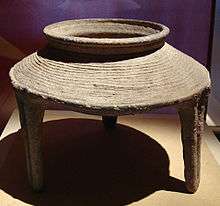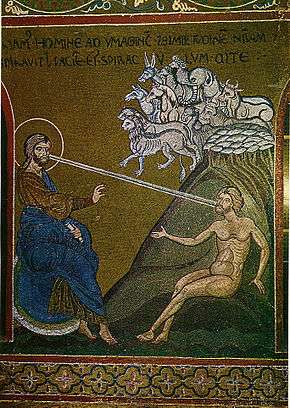6th millennium BC
| Millennia: | |
|---|---|
| Centuries: |
|
The 6th millennium BC spanned the years 6000 through 5001 BC. It falls into the Holocene climatic optimum, with rising sea levels. Culturally, Mesopotamia is in the Pottery Neolithic (Halaf culture), and agriculture spreads to Europe and to Egypt.
World population grows dramatically as a result of the Neolithic Revolution, perhaps quadrupling, from about 10 to 40 million, over the course of the millennium.[1]
Culture

Yangshao culture
- Near East
- c. 6000 BC: The Chalcolithic comes to the Fertile Crescent. (Roux 1980) First use of copper in Near East.[2]
- c. 6000 BC: Brick building was taking place at modern-day Çatalhöyük, Turkey.[3]
- Agriculture appears in the Nile valley.
- c. 6000 BC–5900 BC: Earliest evidence of wine, Georgia.[4]
- c. 5800 BC: The Hassuna culture in Mesopotamia (t. 5500 BC), with the earliest version of stamp seals. (Roux 1980)
- c. 5500 BC: Beginning of Tell Zeidan in Syria (Ubaid).
- c. 6th millennium BC: Beginning of Teppe Hasanlu in Iran.
- c. 6th millennium BC: Beginning of Zayandeh River Culture in Iran, including Sialk.
- c. 5500 BC–4800 BC: Samarra culture at Mesopotamia (present day Iraq) begins (c. 5700 BC – 4900 BC C-14, 6640 BC – 5816 BC calBC).
- c. 5400 BC: Irrigation and the beginning of the Sumerian civilization in Southern Iraq.
- c. 5100 BC: Temples founded in southern Mesopotamia.
- c. 5000 BC: Metsamor Armenia neolithic stone circles.
- Europe
- c. 6000 BC: Fully Neolithic agriculture has spread through Anatolia to the Balkans. (1967 McEvedy)
- c. 6000 BC: Cycladic culture begin to use a coarse local type of clay to make a variety of objects.
- c. 6000 BC: Female figurines holding serpents are fashioned on Crete and may have been associated with water, regenerative power and protection of the home.
- c. 5900 BC: Vinča culture emerges on the shores of lower Danube.
- c. 5900 BC: Beginning of human inhabitation in Malta.[5]
- c. 5500 BC: Beginning of the Cucuteni-Trypillian culture in the region of modern-day Romania, Moldova, and southwestern Ukraine.
- c. 5500 BC: Earliest evidence of cheese-making (Kujawy, Poland).[6]
- c. 5500 BC Danubian culture
- c. late 6th and early 5th millennium BC: Beginning of Samara culture at the Samara bend region of the middle Volga, Russia.
- South Asia
- c. 6000 BC: Junglefowl kept in India.
- c. 5500 BC: Pottery at Mehrgarh in current-day Balochistan, Pakistan.
- China
- c. 5800 BC: Beginning of the Dadiwan culture in China.
- c. 5500 BC: Beginning of the Xinle culture in China.
- c. 5400 BC: Beginning of the Zhaobaogou culture in China.
- c. 5300 BC: Beginning of the Beixin culture in China.
- c. 5000 BC: Beginning of the Hemudu culture in China, cultivation of rice.[7]
- c. 5000 BC: Beginning of the Daxi culture in China.
- c. 5000 BC: Beginning of the Majiabang culture in China.
- c. 5000 BC: Beginning of the Yangshao culture in China.
- New World
- The oldest forms of Sydney rock engravings are estimated to date to 6000 BC (Sydney, Australia).[8]
- c. 5600 BC: The Red Paint People become established in the region from present-day Labrador to the state of New York.
- c. 5000 BC: Agriculture may have begun in the Americas.[3]
Environment
| Preceded by the Pleistocene |
| Holocene Epoch |
|---|
|
|
- A massive volcanic landslide off Mount Etna, Sicily, caused a megatsunami that devastated the eastern Mediterranean coastline on the continents of Asia, Africa and Europe.[9]
- c. 6000 BC: The entire 6th millennium was a part of the Holocene climatic optimum (so were the 4th, 5th, and 7th millennia). This was a warm period also known as the Atlantic period and was characterized by minimal glaciation and high sea levels. (McEvedy)
- c. 6000 BC: Doggerland, the land bridge connecting England with the rest of Europe, disappears beneath the waters of the North Sea and the English Channel.
- c. 6000 BC: Peak of meltwater pulse 1C, leading to a rapid rise of sea level by about 6.5 m in less than 140 years.[10]
- c. 6000 BC: Equidae (horses) disappear from the Americas.
- c. 5760 BC: The volcano Puy de Dôme in France erupts.
- c. 5677 BC: Cataclysmic volcanic eruption of 12,000-foot (3,700 m) high Mount Mazama creates Oregon's Crater Lake[11] when the resulting caldera fills with water. It is the largest single Holocene eruption in history of the Cascade Range, with a Volcanic Explosivity Index of 7.
- c. 5600 BC: Beginning of the desertification of North Africa, ultimately leading to the creation of the Sahara desert. This process may have spurred migration to the region of the Nile in the east, thereby laying the groundwork for the rise of Egyptian civilization.
- c. 5600 BC: According to the Black Sea deluge hypothesis, the Black Sea floods with salt water. Some 3000 cubic miles (12,500 km3) of seawater is added, significantly expanding the body of water and transforming it into a sea from a fresh-water landlocked lake.
- c. 5450 BC: Hekla volcanic eruption.
Astronomy and calendars

Byzantine Calendar illustrating 1 September 5509 BC (the calendar is from the 12th century).
- The Byzantine calendar was used in the Byzantine Empire and many Christian Orthodox countries and Eastern Orthodox Churches and was based on the Septuagint text of the Bible. That calendar is similar to the Julian calendar except that its epoch is equivalent to 1 September 5509 BC on the Julian proleptic calendar.
- The 6th millennium BC falls within the zodiacal age of Gemini (c. 6450–4300 BC)[12]
References
- ↑ Jean-Noël Biraben, "Essai sur l'évolution du nombre des hommes", Population 34-1 (1979), 13-25.
- ↑ Bailey (1973)
- 1 2 Roberts, J: History of the World. Penguin, 1994.
- ↑ "Georgia made 'world's oldest wine'". BBC News. 2017-11-13. Retrieved 2017-11-14.
- ↑ "700 years added to Malta's history". Times of Malta. 16 March 2018. Archived from the original on 16 March 2018.
- ↑ "Art of cheese-making is 7,500 years old". Nature. 12 December 2012.
- ↑ G.W. Crawford and C. Shen, "The Origins of rice agriculture: recent progress in East Asia", Antiquity 72(278):858-866 (December 1998), doi:10.1017/S0003598X00087494
- ↑ Hidden in plain sight: Indigenous Australian rock art on Sydney's doorstep by The Guardian (Author: Brigid Delaney)
- ↑ Pareschi, M. T.; Boschi E.; Favalli M. (2006). "Lost tsunami". Geophysical Research Letters. 33 (22): L22608. Bibcode:2006GeoRL..3322608P. doi:10.1029/2006GL027790.
- ↑ Blanchon, P., and Shaw, J. (1995) Reef drowning during the last deglaciation: evidence for catastrophic sea-level rise and icesheet collapse. Geology, 23:4–8.
- ↑ Zdanowicz, C. M.; Zielinski, G. A.; Germani, M. S. (1999). "Mount Mazama eruption; calendrical age verified and atmospheric impact assessed". Geology. 27 (7): 621–624. Bibcode:1999Geo....27..621Z. doi:10.1130/0091-7613(1999)027<0621:MMECAV>2.3.CO;2.
- ↑ Mann, Neil, W.B. Yeats and a Vision: The Astrological Great Year, 2000s
This article is issued from
Wikipedia.
The text is licensed under Creative Commons - Attribution - Sharealike.
Additional terms may apply for the media files.